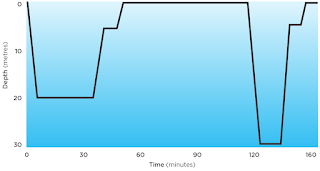Reverse Diving Profiles
In the world of scuba diving, safety is paramount. Every diver is trained to follow certain protocols and guidelines to minimize risks and ensure enjoyable experiences beneath the waves. One such guideline that has sparked debate and discussion over the years is the concept of reverse diving profiles.
 |
| Reverse Diving Profiles |
Reevaluating Traditional Wisdom
Traditionally, divers have been advised to start their dives deep and gradually ascend, a practice known as a forward profile. This approach is based on the principles of decompression theory and aims to reduce the likelihood of decompression sickness (DCS) by allowing the body to off-gas nitrogen slowly as the diver ascends.
Insights from Research and Workshops
However, with the advent of dive computers and advancements in dive research, the once strict adherence to forward profiles has come under scrutiny. Contrary to the expectations of many, data has emerged showing that divers engaging in reverse profiles—dives where the deepest portion of the dive occurs towards the end—were not experiencing disproportionate incidents of DCS.
In 1999, a significant gathering of physiologists and dive community experts convened at the Smithsonian Institute to address the issue of reverse profiles. After thorough examination of available data, the workshop concluded that there wasn't compelling evidence linking reverse profiles to higher DCS risks.
Recommendations for Reverse Profiles
The workshop proposed a more relaxed approach to reverse profiles, particularly for shallow dives less than 40 meters (130 feet) and with depth differences of 12 meters (40 feet) or less. This recommendation was based on the understanding that minor variations in depth during a dive may not pose significant risks, especially when followed by appropriate safety measures such as a safety stop.
Practical Considerations and Diver Training
Despite the evolving understanding of reverse profiles, many dive organizations, including PADI, continue to advocate for forward profiles in their training materials and practices. As a PADI Career Development Centre, Oceans 5 adheres to PADI's guidelines, which emphasize starting with the deepest dive. Additionally, Oceans 5 recognizes that its instructors and divemasters, who dive regularly and accumulate nitrogen exposure, may not fit the typical recreational diver profile for whom dive tables and computers are designed.
Conclusion
Given the conservative nature of dive training materials and the unique diving habits of its staff, Oceans 5 chooses to err on the side of caution by abstaining from conducting reverse profiles. While the data may suggest that reverse profiles can be conducted safely under certain conditions, the lack of formal testing and the professional context of Oceans 5's team warrant a cautious approach.
In conclusion, the debate surrounding reverse diving profiles underscores the dynamic nature of dive safety practices. While new evidence challenges traditional guidelines, caution and adherence to established protocols remain crucial. Whether one chooses to embrace reverse profiles or stick to forward profiles, prioritizing safety and responsible diving practices is paramount for enjoyable and risk-free underwater adventures.
Reacties
Een reactie posten